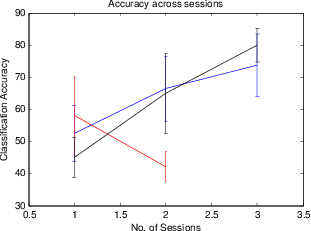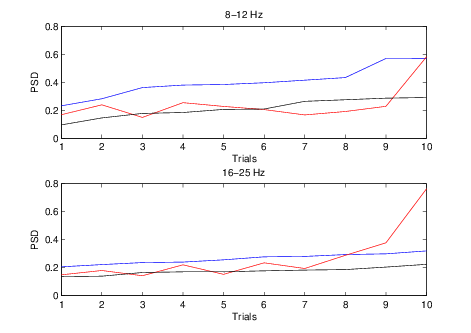Section: New Results
A study on Natural user feedback in BCI with peripheral sensory stimulation toward efficient motor learning
Participants : Saugat Bhattacharyya, Maureen Clerc, Mitsuhiro Hayashibe.
Brain-computer Interfacing (BCI) measures the neural activity of the brain to create a direct communication channel to peripheral devices in form of robots, prosthesis, wheelchair or a computer controlled by the user, independent of the peripheral nerves and muscles. To improve the performance of the BCI operation and provide a feedback to the user as an indication of his/her achievement in terms of voluntary brain modulation, a feedback in form of visual, auditory or (vibro-)tactile medium can be provided to the user during training.
One can employ Functional Electrical Stimulation (FES) targeting specific muscle group as a feedback modality in BCI research. Functional Electrical Stimulation (FES) is often applied during rehabilitation to directly engage muscles of the affected side of the body. FES is capable of reconstructing certain daily life skills for physically challenged patients by directly stimulating the targeted muscles group. Thus, it is quite natural to combine FES rehabilitation with BCI systems, where the FES can activate the sensory channel to provide a maximal inflow in the brain and the BCI would provide an efferent outflow of motor commands to close the motor loop. Thus, we aim at studying the effect of electrical stimulation (ES) on the motor imagery EEG and to implement the usage of ES as a natural feedback to BCI. The purpose was to extract all relevant information from the current EEG dataset acquired during BCI experiment with FES based neuro-feedback and to compare the results to the classical visual neuro-feedback paradigm.
The EEG data in this study were recorded from 14 right-handed participants (11 male and 3 female) with a mean age of 28 years and standard deviation of 9 years. The experiments took place at Inria Montpellier and Inria Sophia Antipolis centers. In this experiment, we abide by the norms of the local Inria ethical committee. The participants sat in front of a display placed at eye level and performed the following cued motor imagery tasks: left hand movement, right hand movement, left foot movement and right foot movement. The participants were randomly divided into two groups: one group was provided with only visual feedback (VIS) and the other group was relayed with only FES as feedback during the motor imagery tasks. This step was taken in the experimentation so that the groups were not influenced by both feebacks and were trained on only one feedback. The VIS feedback group received the feedback in form of a uni-directional bar whereas the FES feedback group received the feedback in form of electrical stimulation on their respective limbs. The group with FES feedback performed two different sets of experiment, which are: 1) the participant performed the motor imagery tasks while receiving electrical stimulation as feedback, which we term as FES-Active (ACT) sessions, and 2) the participant performed no motor imagery tasks (relaxation condition) and received the electrical stimulation as a stimuli, which we term as FES-Passive (PAS) sessions.
The raw EEG data was first filtered using a notch filter to remove the 50Hz noise from the signal. Then, a 4th order Butterworth filter was applied to the signal. Then, the mean of the signal was removed followed by a spatial filtering using common average referencing technique. Finally, the continuous EEG data were segmented into smaller samples (Epochs) from -1s to 4s, where 0 indicates the onset of the motor imagery task (left hand, right hand, right foot). After filtering and epoching the EEG data, the EEG epochs are spatially filtered using common spatial patterns (CSP) algorithm. Then, the log-variance of 4 discriminating CSP filters (2 for either classes) were selected as features. These features are then used as inputs to a linear discriminating analysis (LDA) classifier to derive the output of the current motor task imagined by the participant. We provide the average classification result across all subjects for three (ACT and VIS) and two sessions (PAS) in Fig.11. As noted from the figure, the performance of the decoder improves after every session for the VIS and ACT sessions. This can be attributed to the increase in learning occurring to the participant during the progression of the experiment. As the subject was performing no mental tasks during the PAS session, thus, no such improvement on the classification performance is noticed. On the contrary, a decrease in the performance is noted after the second session.
To further investigate the learning occurring across trials, we have calculated the band power of the epochs at the mu-band (8-12Hz) and the central-beta band (16-25 Hz) at Cz electrode (Fig.12). To calculate the power we have employed Welchs' periodogram at an overlap of 75% and a window size of 250ms. Finally, the average is calculated over all windows of the given trial to determine its power. As seen from the example in Fig.12, ACT and VIS conditions show a monotonic increase of power which can be quantified as an indication of learning occurring in the participant across the trial.



